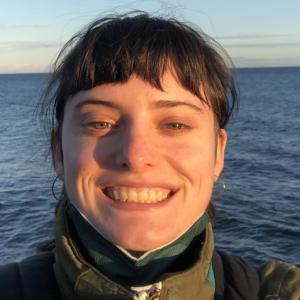Honors: The View from the Far Side
June 16, 2012
Eli Goldberg ’12
For a week after my last round of finals, every night I dreamed that I'd overlooked some major academic obligation. Sometimes I'd forgotten to turn in a paper, or slept through an exam. Usually, though, the issue was my honors project. I'd wake up in the middle of the night and run to my computer, expecting to find an "I'm disappointed in you" email from my advisor. The email was never there. Thesis, defense, presentations... it's really, truly over.
It's really, truly over, and I managed not to post about any of it. Some people can blog away merrily throughout the honors process, but every time I sat down to write about my thesis in progress, it felt like bragging about a baby before it was born: sure, everything seemed fine, but for all I knew I'd find out at my next advising meeting that it actually had seven heads. Better not to jinx anything by speaking too soon. But now that I've graduated with the words "high honors" printed on my diploma, it finally feels safe to say something.
On Sunday, April 15th, 2012 at 11:11 PM, I submitted my honors thesis. It is 142 pages long and contains 30 figures and 16 tables. Its name is Archaeometric Characterization of Roman Tile Fabrics from the Sangro Valley, Italy. Here's a picture of it after my defense - isn't it gorgeous?

Entering Oberlin as a budding young academic, I was certain that I would study classical archaeology and cocksure about the fact that I would do an honors project. I was less sure of the topic. I imagined that one day it would come to me in a vision, Zeus thundering, "You will study the relationship between domestic space and systems of social status in the Roman republic!" Or perhaps I'd pull down a textbook from one of my favorite classes and let it fall open to a random page: "Okay, my thesis will be about museums and imperialism in Victorian England." Instead, I found my thesis subject by hauling it up from a dusty trench in the middle of a hot Italian summer.
The summer before my sophomore year, I shipped out for a season of archaeological field school with the Sangro Valley Project. (If this sounds familiar, it's because I blogged about the SVP here.) On the first day of excavation the students lined up, received our loaner trowels, and scattered across the site to start moving dirt. I was deposited right on top of a collapsed Roman roof, now reduced to a massive heap of broken tiles. We pulled up over one ton of tile fragments before hitting bottom; it took the better part of a month.
Most of the students that summer rotated in and out out of the tile fall, spending a few mornings there before moving on to more exciting areas of the dig. Somehow, I was the one who got stuck in Tile Town, pulling up material that I'd be studying for the next three years.


A good research project starts early and incubates for a long time. Before my work became an honors thesis it was a private reading, a Winter Term project, a summer research assistantship, and a grant proposal. I trawled through library catalogs and online databases, devoured all of the sources that I could find, and learned to look at tile a thousand different ways before settling on one: characterizing the chemistry and mineralogy of tiles and clays from the Sangro Valley, in an attempt to match materials to their sources.
There were a few great things about this project:
- It was the most sensible way of dealing with some really complicated material, and had the potential to shed light on some of the Sangro Valley Project's research questions.
- It was a good way to apply my chemistry minor to my archaeology major - two subjects that I started studying out of pure curiosity, but that turned out to be deeply connectable.
- It gave me an excuse to spend two more summers in Italy, collecting data, taking samples, and eating ridiculous amounts of pasta.
- Most importantly, I got to use a ray gun! Here's the final phase of lab work last August - measuring the concentrations of trace elements in tile samples using a portable x-ray fluorescence spectrometer:

So I designed my study, collected my data, and entered the long hard slog of running statistical analyses and writing everything up. There are a lot of stories that I could tell about the process of writing my thesis senior year - most of them involve sitting in Slow Train for hours, trying to make my coffee last as long as possible - but I'll just share one piece of advice: if you accidentally doze off during a late night in the library, when the building closes at 2 AM, you will get locked in. Don't panic, just call Safety & Security. They'll come to let you out once they finish laughing.
Some days it seemed like everything was going fantastically well; more often, I thought I'd never make it through. For so long I had taken it for granted that I would do an honors project - it seemed like the logical step on my way to becoming an archaeology professor. But in the depths of honors hell, juggling my thesis with extracurricular commitments and considering my next steps after college, I began to question whether that was what I really wanted to do. This was terrifying, but also freeing: I could start to think about my project not as a stepping-stone to a career in academia, but as a capstone that pulled together all of the knowledge and skills I'd acquired at Oberlin, and a learning experience in its own right. It took off the pressure I felt to write the perfect thesis that would wow every grad school admissions committee, and made it easier to enjoy the challenge as it unfolded - late nights in the library and all.

Surviving honors meant setting aside my determination to do everything perfectly the first time, and learning to ask for help. Weekly meetings with Susan, my advisor and the chair of the Archaeological Studies program, yielded critiques and pep talks that kept me moving. To my surprise, professors from other departments were equally eager to help. Although I'd barely taken any geology, Bruce Simonson and Zeb Page proved willing to sit down at a moment's notice to pop a sample under a microscope or talk about the minerals I was seeing in tiles; in the Math department, Jeff Witmer was invaluable in helping me to untangle a mess of variables and data points.
I highlight the professors that I worked with not just because of their general awesomeness, but also because I think their involvement says something about Oberlin's dedication to student research and interest in interdisciplinary work. Not only did I have the support of faculty and majors in my program, but I was actively encouraged to stray into other areas. I consistently found that professors I'd never met before were eager to hear my ideas and give me a second opinion... and a third... and a fourth...
It was my ultimate responsibility to sift through this multiplicity of perspectives on an infinitely complex data set, jump the gap between the physical sciences and social sciences, and come up with one coherent narrative about my tiles. Then I had to convince everyone that I was more or less right - over and over, in meetings, abstracts, presentations, my thesis. When I finally walked into the room for my defense, I was ready to speak for my work in front of a committee of brilliant and intimidating people. Each of them was an expert on some aspect of my research - but no one knew the full picture better than I did, and no one could explain it as well.

I spent most of the academic year counting down to the day when every honors deadline would be behind me. That day has come, but I'm still not really done. Instead of making sense of my research, I'm now finding ways to share it with the world: presenting at the Senior Symposium, answering incessant questions from friends and family about my thesis, writing things up for possible publication (wish me luck!), writing this post... The episodes of waking up alone in a dark library at 3:30 AM are mercifully past, but I've still got tile on my mind.
This is the problem and the delight of research: it doesn't end just because someone handed me a diploma with "honors" printed on it. Three years spent contemplating piles of tiles have left me with a big story to tell and a keen sense of just how much more work there is to do. I may not see my career in roof tile research, but I'll probably never stop wondering about it... which is exactly how it should be.
I've skated over most of the technical details of my research, but my whole thesis is available here for the curious. If you find any typos, please don't tell me!
Tags:
Similar Blog Entries
Oberlin in Days Past, Pt. 2
November 29, 2022


A Final I Liked Writing and an Introduction to Research at Oberlin
June 1, 2022
